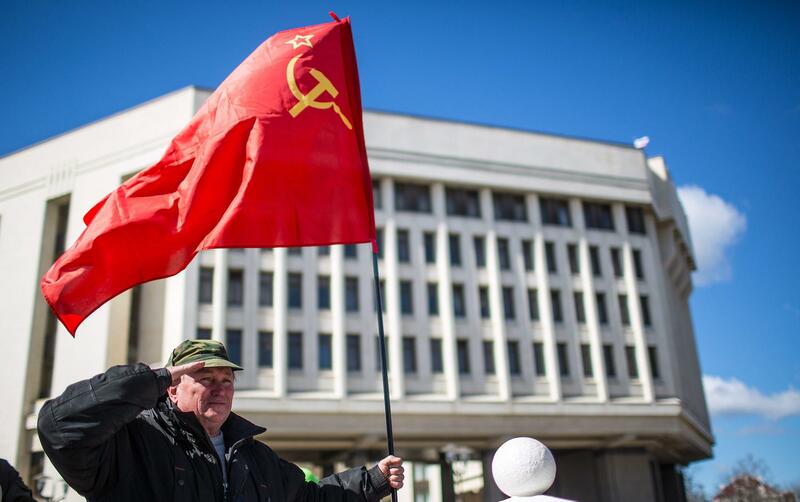Flag of the Soviet Union
Soviet Union Flag
Flags of the World
- North Korea - Bangladesh Flag - Bhutan Flag
- Turkmenistan Flag - Kazakhstan Flag - Tajikistan Flag
Russian Flag - China Flag - Mongolia Flag - Syrian Flag
When one thinks of the Soviet Union, there are few images less stirring and memorable the flag of the Soviet Union.
Love it or loth it if you lived through any part of the cold war, or like to watch movies from that period the golden hammer and sickle emblazoned on a red background will stick in your mind.
The flag of the Soviet Union was the official national flag of the Union of Soviet Socialist Republics from 1923 until 1991.
It is said that the struggles of the common man inspired its design during the brutal Russian Revolution of 1917. Even today there is nothing that symbolizes communism more than the flag known as the red banner.
Flag Design
If you missed it the design of the flag of the Soviet Union is formed of a completed red banner. On the solid red background in the top left-hand corner sits a golden emblem created of a crossed hammer and sickle (in gold). Above the hammer is found a red star with a golden outline. There has always been a little debate as to what should be on the back of the flag, commonly the rear of the Soviet flag should remain plain red although many flags were hand-stitched or woven so the emblem from the front would be reflected on the back (in reverse).
Symbolism of the Soviet Union Flag
So what does the flag of the soviet union all mean?
The colour red has always traditionally been important in Russian culture, in the design of the Soviet flag, it means a little more. The red found on the flag of the Soviet union symbolizes the blood of the workers and farmers spilt during the Russian Revolution of 1917. The red flag also pays homage to the Paris Commune of 1871 when for a brief period the working class overthrew the status quo to rule Paris from March 18 to May 28.
The hammer symbolizes the urban industrial workers, whilst the sickle the agricultural workers, together these two elements of society form the working-class of the Soviet state.
As for the five points of the star, its meaning is a little unclear; it was used extensively during the Bolshevik Revolution and the Russian Civil War. Popular theory says that the five points of the star relate to:
-
The five fingers of the worker's hand.
-
Five contents that communism has spread to and the friendship amongst these.
-
It represents the five social groups that would eventually lead Russia to communism: youth, military, industrial labourers, agricultural workers or peasantry and the intelligentsia.
Whatever the meaning eventually the star would come to represent the communist party and its strategic positioning above the hammer and sickle reflects the importance of the party above everyone's life.
Across Mongolia and central Asia option B was taught in most schools along with the fact that; The golden border of the red star reflects life, energy and vitality (similar to that of the sun), filled with the sacrifices of the Russian people.
![]()
Soviet Union Flag History
During the 1917 Russian Revolution, the Bolsheviks considered using a simple red flag as the banner of their nation such a flag was already historically commonly associated with socialist movements at that time. However, after Lenin and Marx finally achieved victory, it was decided to incorporate a little more on the nation's flag.
The hammer and sickle were added and the flag adopted in December 1922 although at first the hammer and sickle were a part a larger coat of arms which filled the centre of the flag. The initial 1922 flag looked quite busy and wasn't that popular in November of the following year the soviet flag as we know it took shape.
There was to be a few tweaks and changes to the design until eventually in 1955 after further adjustments to the hammers handle and the shape of the sickle "the Statute on the State Flag of the Union of Soviet Socialist Republics" was passed, and the Soviet flag made official.
Apart from a minor colour change in the 1980s, the Soviet Union flag stayed until the eventual breakup of the Soviet Union in December 1991.

More Soviet Flag Facts
While forming the Soviet Federative Socialist Republic Vladimir Lenin and other government members did consider the inclusion of a sword on the flag. However, it was thought this would make the flag aggressive looking.
As the Soviet Union was the first nation to form a socialist government, and thus design a flag fitting this fact, it was seen as an inspiration for several other countries.
At the time the national flags of Afghanistan, Mongolia, Congo, People's Republic of China, Albania, Angola, North Korea, and Vietnam were inspired by the Soviet flag and borrowed elements from its design.
The Soviet Union may have long gone, but the flag remains in use today, there are still some who look upon it with fondness and nostalgia.
It is used at times in opposition within Russia from the left. Across the globe it is held aloft for communist rallies and still raised during victory, parades commemorating the end of the Second world war.

